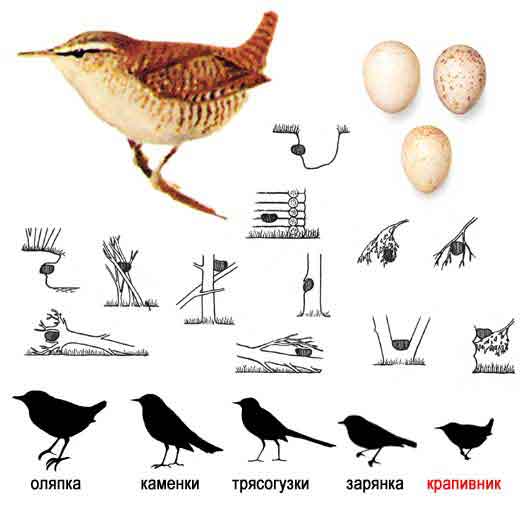Troglodytes is a genus of small passerine birds in
the wren family. These wrens are around 11–13 centimetres
long.
They are brownish above and somewhat paler below, with strong
legs. Their short rounded wings and frequently cocked
tail have a dark barred pattern. The flight is direct and buzzing.
Troglodytes wrens are mostly found in somewhat cooler habitats
than most of their relatives. Most of the species are
found in the mountains from Mexico to northern South America.
Five species are found in temperate latitudes:
The House Wren occurs widely in both tropical and temperate
lowlands, but is frequently split into several species.
Until recently, the hardy Winter Wren was believed to
have a wide distribution in North America, Europe and Asia,
but it has recently been split into three species, of which
the Eurasian Wren is the only wren of any genus found
outside
the New World. The Cobb's Wren of the Falkland Islands
is another species which tolerates harsh conditions well.
Like other wrens, they are elusive as they hunt for small insects
and spiders, but they readily reveal their positions
through their loud songs.
These are territorial birds, but the tiny Winter Wren will roost
communally in a cavity in cold weather to help conserve heat.
|
| English |
Norsk |
Latin |
| (Northern) House Wren |
Hussmett |
Troglodytes
aedon |
| Cobb's Wren |
Falklandssmett |
Troglodytes
cobbi |
| Santa Marta Wren |
Santamartasmett |
Troglodytes
monticola |
| Ochraceous Wren |
Okersmett |
Troglodytes
ochraceus |
| Rufous-browed Wren |
Rustbrynsmett |
Troglodytes
rufociliatus |
| Tepui Wren |
Tepuismett |
Troglodytes
rufulus |
| Socorro Wren |
Socorrosmett |
Troglodytes
sissonii |
| Mountain Wren |
Andessmett |
Troglodytes
solstitialis |
| Clarion Island Wren |
Clarionsmett |
Troglodytes
tanneri |
| Winter
Wren |
Gjerdesmett |
Troglodytes
troglodytes |
Wren,
Troglodytes troglodytes 
Winter Wren
En.
Wren, Da. Gærdesmutte, Du. Winterkoning, Fi. Peukaloinen, Fr.
Troglodyte mignon, Ge. Zaunkönig,
It. Scricciolo, No. Gjerdesmett, Sp. Chochín, Sw. Gärdsmyg
 ©
www.ecosystema.ru/
©
www.ecosystema.ru/
The Winter Wren is found throughout most of Europe and North America
where it inhabits a variety of habitats which
provide it with low cover on which it can forage for the insects on
which it feeds.
It is usually seen foraging within a couple of metres of the ground.
  
©
www.ecosystema.ru/
It is the only wren found in Europe, but like the rest of the wren
family, which is found in the Americas, it is a loud and
melodious singer and is usually heard well before it is seen. Its
characteristic call is a single or double note sounding
like large pebbles being knocked together.

©
www.ecosystema.ru/
It is one of the smallest European birds at about 9 cms but it appears
even smaller by its habit of sticking its very short tail up
in the air. It has a fairly long, thin bill, a buffy supercilium
and dark bars on its wings and flanks.
It scientific name means "cave dweller" and this derives
from its habit of building its nest in a crevice or hole in walls,
trees or steep banks.
There are 13 sub-species of Winter Wren in Europe one of which is
the St Kilda Wren.
20-26 million breeding pairs of this widespread and numerous bird
throughout Europe, becoming rarer eastwards into
Russia and northwards in Scandinavia.
text:
Arthur Grosset
|












